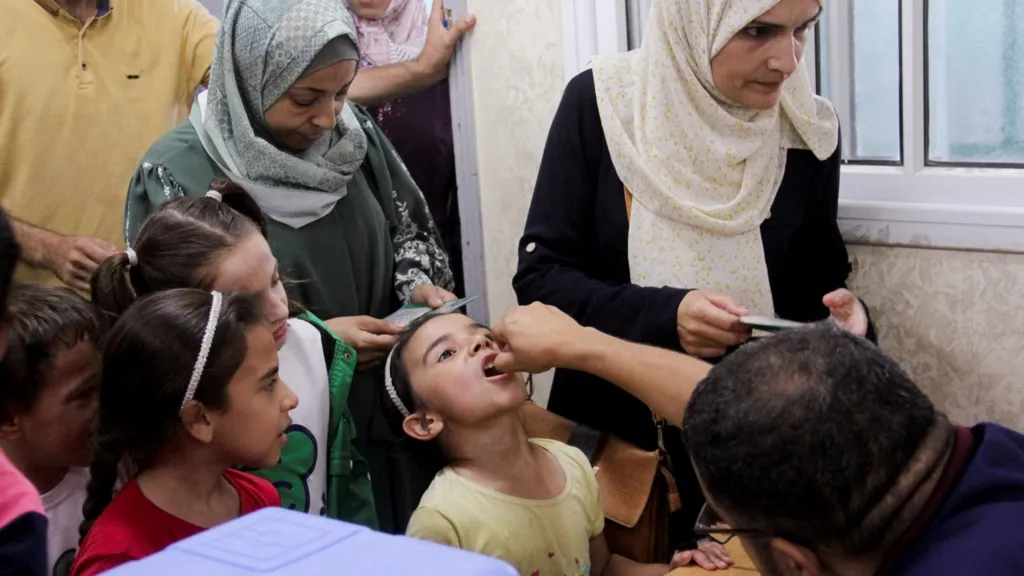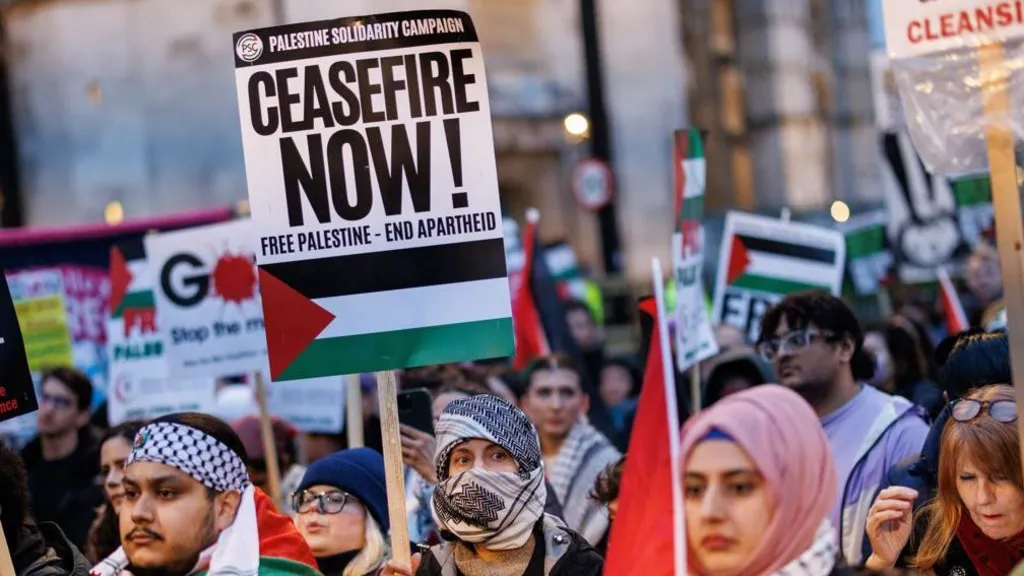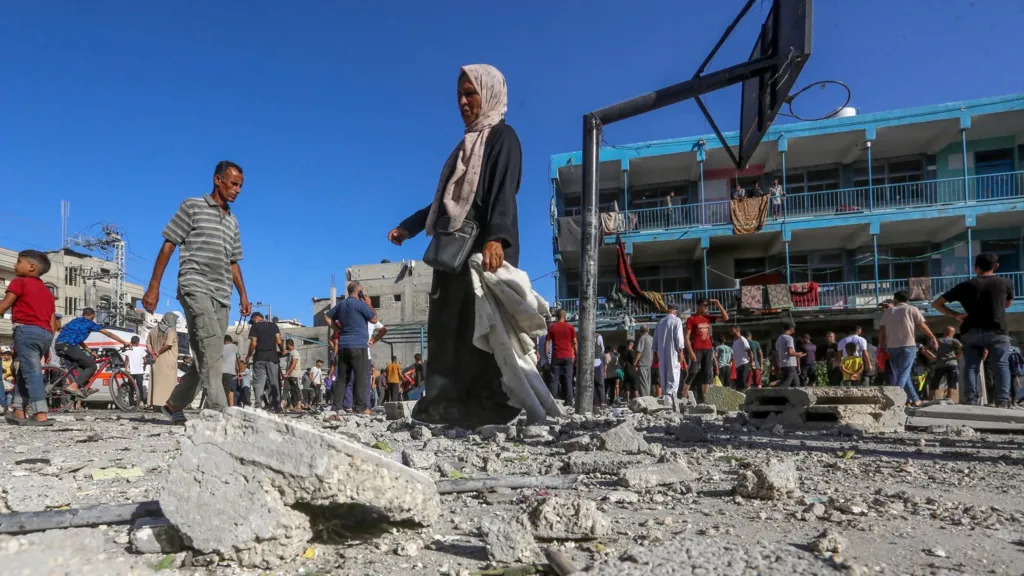By Charalampos Karouzos,
The recent war in Gaza has brought a humanitarian crisis that goes beyond the immediate impact of violence, and one of the most pressing health concerns that has emerged is the resurgence of polio. With the first case of polio in the region in 25 years, the need for vaccination has become more urgent than ever. With the war disrupting healthcare services and displacing families, the risk of polio spreading among vulnerable children has increased dramatically, with cases of virus-related paralysis in children being identified.
To start, polio, or poliomyelitis, is a highly infectious disease caused by the poliovirus, which primarily affects children under the age of five with the virus spreading rapidly through person-to-person contact, often via contaminated food or water. Once inside the body, the virus multiplies in the intestines and can invade the nervous system, causing paralysis. Indeed, in severe cases, polio can be fatal if the paralysis affects the muscles used for breathing. While not everyone affected will develop symptoms, approximately 1 in 200 cases result in permanent paralysis and among those paralyzed, 5 to 10% will die when the respiratory muscles become immobilized.
Historically, polio was a devastating disease for humanity, and during the first half of the 20th century, it paralyzed and killed thousands of people, primarily children, across the world. However, with the introduction of effective vaccines in the 1950s and global vaccination campaigns, polio was brought to the brink of eradication. In fact, by 2021, the World Health Organization (WHO) reported that the incidence of polio had decreased by more than 99%, saving millions of lives.

However, the recent war in the Gaza Strip has become the most recent and unfortunately not isolated, incident of Poliovirus spread in the world, becoming part of a broader global challenge. The recent increase in the number of cases, contrary to the trend of previous years, stems from a critical decision made by global health authorities in 2016, which removed a type of poliovirus known as Type 2 from the oral polio vaccine. This decision, now referred to as “the switch”, was made after Type 2 had been eradicated in the wild, with the hope that removing it would help eliminate vaccine-derived outbreaks.
Unfortunately, the result was exactly the opposite. “The switch” left gaps in immunity, particularly in areas with poor vaccination coverage, and therefore in the years following, cases of vaccine-derived polio increased tenfold, leading to outbreaks in dozens of countries, including those neighboring Gaza. The poliovirus that paralyzed a child in Gaza in 2024, for instance, most likely, according to genetic studies, traveled a long path from Nigeria, through Chad and Sudan, before finding a foothold in Egypt, and ultimately reaching Gaza.
In conflict zones like Gaza, the risk of polio transmission, along with other pathogens, is amplified by the destruction of healthcare infrastructure, population displacement, and overcrowded living conditions. Before the recent conflict, Gaza’s vaccination rates were impressive, hovering around 99%, but as war has ravaged the region, the vaccination rate has dropped to 86%, well below the threshold needed to effectively prevent outbreaks.
The analysis of the increased cases of polio and the accumulation of evidence, although important to better understand the situation, do not directly target the challenges of increasing vaccination rates. One of the most effective ways to control polio is through door-to-door vaccination campaigns, thus ensuring that every child, especially those in hard-to-reach areas, receives the vaccine. Unfortunately, in Gaza, the ongoing war has made such campaigns almost impossible, as thousands of families have been forcefully displaced, homes and infrastructure have been destroyed, and people are constantly on the move, with many children at risk of being missed by health workers.
Furthermore, the Israeli Government’s reluctance to fully cooperate with the WHO’s vaccination plans has hampered efforts. While health officials aimed to conduct a seven-day vaccination campaign beginning in the north of Gaza, where many unvaccinated children reside, they were forced to alter their strategy. Instead, the campaign did start in the central zone, leading to delays in reaching the most vulnerable populations.
Despite these challenges, early vaccination efforts have exceeded expectations, as health workers have managed to immunize many more children than initially anticipated, suggesting that some families may have traveled to vaccination sites from other parts of Gaza. However, the current situation remains dire, and without sustained efforts, the virus could spread rapidly through unvaccinated populations at an unprecedented rate. It must be highlighted that by vaccinating children, not only are individuals protected, but the transmission of the virus to others in the community is also interrupted.
Although polio has been eliminated in many parts of the world, the virus still exists in regions facing challenges like Afghanistan and Pakistan. As long as the virus remains anywhere, it poses a threat to children everywhere in the world, thus making vaccinations in Gaza a vital step in the larger global mission to completely eradicate polio and protect future generations from this preventable disease.

Moving forward to the future, the polio outbreak in Gaza is a health emergency that indicates again how fragile progress can be, particularly in areas affected by conflict. Global health officials are now racing against time to vaccinate as many children as possible and prevent the virus from gaining a stronger foothold in the region. Fortunately, the vaccine being used in Gaza is a newer version of the Type 2 oral vaccine, which has reduced the risk of vaccine-derived outbreaks by 80%, according to the NYT-related article.
However, although the vaccination process has been more successful than expected, much more needs to be done. As the war in Gaza continues, international organizations must find solutions to reach unvaccinated children, while also addressing the broader challenges of healthcare access and sanitation. The WHO and other health organizations remain optimistic that with sustained effort, polio can still be eradicated, even in conflict zones like Gaza.
The resurgence of polio in Gaza is not solely a wake-up call for global health authorities and governments alike, but another piece of solid evidence that highlights the devastating truth of war for humanity. Amid a devastating war that has even violated fundamental human rights, the last thing the children of Gaza need is the added burden of a preventable disease like polio. Although the current vaccination campaign offers hope, the path ahead is fraught with challenges. It is crucial that the international community continues to support efforts to vaccinate Gaza’s children and ensure that they are protected from this debilitating disease, which can only be beaten if we remain vigilant and committed to the cause.
References
- The Pivotal Decision That Led to a Resurgence of Polio. The New York Times. Available here
- WHO. Available here
- CDC. Available here
- ECDC. Europa. Available here
- Global Polio Eradication Initiative. WHO. Available here
- Wild poliovirus spreads across Pakistan and Afghanistan. science. org. Available here




